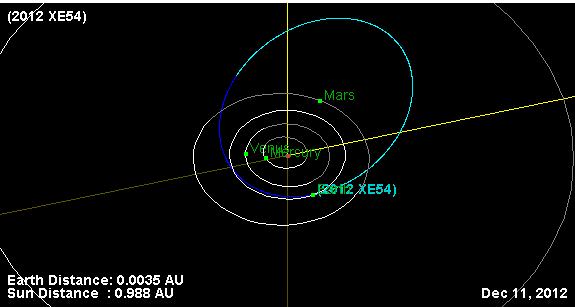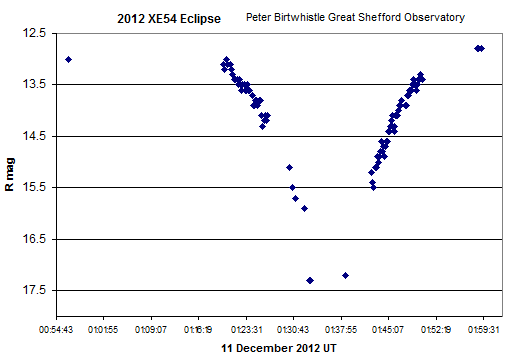Image of Asteroid 2012 XE54 taken with the the H06 ITelescope network near Mayhill, New Mexico on December 11, 2012, through a 0.25-m f/3.4 reflector + CCD. Credit: Ernesto Guido & Nick Howes, Remanzacco Observatory.
A newly discovered small asteroid named 2012 XE54 passed harmlessly by Earth early today and as predicted it was eclipsed by Earth’s shadow, causing its light to “wink out” for a short time, about 40 minutes.
Above is an image of the asteroid from Ernesto Guido and Nick Howes using a 0.25-m f/3.4 reflector + CCD with the ITelescope facility near Mayhill, New Mexico. It is a single 60-second exposure, “taken with the asteroid at magnitude ~13.2 and moving at ~630 “/min. The asteroid is trailed in the image due to its fast speed. At the moment of the close approach 2012 XE54 will move at ~ 720″/min… North is up, East is to the left,” wrote Guido and Howes on the Remanzacco Observatory website.
Below is an animation showing the movement of 2012 XE54, using three consecutive 60-second exposures. This asteroid was zipping right along at a fast pace, at a distance from Earth of about 226,000 km (141,000 miles) or about .6 lunar distances.
2012 XE54 Animation December 11, 2012, by E. Guido & N. Howes
Pasquale Tricarico of the Planetary Science Institute had predicted that the asteroid would pass through the Earth’s shadow, creating an asteroid eclipse, a rather rare event that is similar to an eclipse of the full Moon by Earth’s shadow. At 01:22 UTC on December 11 the eclipse began, and it left Earth’s shadow at 02:00 UTC. Those watching the asteroid noted that the asteroid “disappeared” from its track, and then reappeared after leaving Earth’s shadow.
“In two images taken at 01:30:16 and 01:31:18, 60sec exposure, 2012 XE54 appeared as a very faint and long track, then… nothing. In the following images there is no visible track. Wonderful!” wrote Elia Cozzi from the New Millennium Observatory, posting in the mpml asteroid research group message board.
Orbital diagram of Asteroid 2012 XE54 from JPL’s Small Body Database.
While we don’t have images to share of that event, as Guido and Howes mentioned, Peter Birtwhistle produced a lightcurve (see graph below) of the eclipse:
Tricarico wrote that the first known case of an asteroid being eclipsed by Earth’s shadow was “Asteroid 2008 TC3 which was totally eclipsed just one hour before entering Earth’s atmosphere over Sudan in 2008, and asteroid 2012 KT42 experiencing both an eclipse and a transit during the same Earth flyby in 2012.”
Guido and Howes also mentioned that their work last night was “in memory of our dear friend & colleague Giovanni Sostero.”





WHOOSH! That little bugger almost parted my hair!
You are a gas (giant)
In that animated GIF, are there two other (much shorter) asteroid trails?
I think they are just meteors that happened to hit the atmosphere when the photo was taken. They are not relevant.
Just was wondering: Why in the clip are some of the stars moving? There is a cluster of three in the middle that moves back and forth as well as some in the upper left. Some also look to only be in the first clip. Anyone have a educated insight?
Could be satellites? Or UFOs.
If you are referring to “UFOs” as an alien intelligence. We are limited by the speed of light throughout this entire universe, so there will not be any aliens or intelligent UFOs that we will be seeing in pictures or visiting us, EVER. We or any other aliens won’t be able to travel beyond the speed of light within our galaxy because the universe itself is spinning and expanding at the same time and the moment we do travel faster than light, we are knocked out of the universe or left in another part of empty space in a different time period with no means of reaching our destination or going back home unless we “teleport” using quantum entanglement in which we will only be creating a duplicate of yourself within that space time continuum and even, if we figure out how to create this phenomena outside our space time continuum to leave it behind where we first left off ( if you want to “time travel”) or push these particles to our destination (travel in space) everything will still be locked by the speed of light… this is why you don’t see any aliens within our time-frame of existence and within our own timeline or travelling in space or time travelers visiting us. Take all the math clump guessing and theories you want, this is the most probable explanation as to why aliens haven’t visited us and for us to stop once and for all abusing the letters “UFO”.
Joey should investigate the concept of a “chill pill”.
You cannot be certain unless you look at the equipment that took the picture which is probably using some high reflective liquid metal to capture the images (mercury stuff). Also you have to think about the digitization of the actual picture, compression and data being passed by computer to computer. If you zoom into the “stars that are moving” you can see the pixels seem to match each other and are square not round like the pixels of the starts, probably meaning that it came after the images were taken meaning it has nothing to do with the original picture but just something wrong with something.